I haven't provided detailed commentary on the US labour market for a while now. To…
Australian labour market – staggering along with elevated levels of labour waste persisting
The Australian Bureau of Statistics released the latest data today – Labour Force, Australia, September 2019 – which reveals the fairly weak labour market conditions have persisted. Employment growth barely kept pace with the underlying population growth. With the weakness impacting on job opportunities, the participation rate fell which meant that the weak employment growth still outstripped the rise in the labour force and so unemployment fell by a bit. A decline in unemployment is sometimes a cause for celebration. But when it occurs under these circumstances – weak employment growth and declining participation – it signals a poorly functioning labour market starved of demand. The ony positive sign was that full-time employment increased but that was really just a reversal of last month’s decline. The fact is that full-time employment is still below the level attained in December 2018. Broad labour underutilisation is at 13.5 per cent. Both the unemployment and underemployment rates are persisting around these elevated levels of wastage making a mockery of claims by commentators that Australia is close to full employment and that the fiscal position represents something desirable. The unemployment rate is 7 percentage points above what even the central bank considers to the level where inflationary pressures might be sourced from the labour market. This persistence in labour wastage indicates that the policy settings are to tight (biased to austerity) and deliberately reducing growth and income generation. My overall assessment is the current situation can best be characterised as remaining in a fairly weak state.
The summary ABS Labour Force (seasonally adjusted) estimates for September 2019 are:
- Employment increased by 14,700 (0.1 per cent) – Full-time employment increased by 26,200 and part-time employment decreased by 11,400.
- Unemployment decreased by 8,100 to 709,600 persons.
- The official unemployment rate decreased by 0.1 points to 5.2 per cent mostly because participation fell in the face of weak employment growth.
- The participation rate decreased by 0.1 points to 66.1 per cent.
- Aggregate monthly hours worked increased by 4.1 million hours (0.2 per cent).
- Underemployment decreased by 0.2 points to 8.3 per cent (1,139.7 thousand) and the total labour underutilisation rate (unemployment plus underemployment) decreased 0.2 points to 13.5 per cent. There were a total of 1,849.3 thousand workers either unemployed or underemployed.
Employment barely increases in September 2019
Employment increased by 14,700 (0.2 per cent) – full-time employment increased by 26,200 and part-time employment decreased by 11,400.
This is not a strong result.
But the shift between full-time and part-time meant that hours of work increased overall and underemployment fell a little (see below).
The following graph shows the month by month growth in full-time (blue columns), part-time (grey columns) and total employment (green line) for the 24 months to September 2019 using seasonally adjusted data.
The zig-zag pattern where employment growth has regularly been around zero remains evident.
The following table provides an accounting summary of the labour market performance over the last six months. As the monthly data is highly variable, this Table provides a longer view which allows for a better assessment of the trends.
Assessment:
1. Total employment has barely kept pace with population growth.
2. Employment has lagged behind the labour force growth because participation has risen over the period which has pushed unemployment up.
Given the variation in the labour force estimates, it is sometimes useful to examine the Employment-to-Population ratio (%) because the underlying population estimates (denominator) are less cyclical and subject to variation than the labour force estimates. This is an alternative measure of the robustness of activity to the unemployment rate, which is sensitive to those labour force swings.
The following graph shows the Employment-to-Population ratio, since February 2008 (the low-point unemployment rate of the last cycle).
It dived with the onset of the GFC, recovered under the boost provided by the fiscal stimulus packages but then went backwards again as the Federal government imposed fiscal austerity in a hare-brained attempt at achieving a fiscal surplus in 2012.
The ratio was steady in September 2019 at 62.7 per cent and remains below pre-GFC peak in April 2008 of 62.9 per cent.
To put the current monthly performance into perspective, the following graph shows the average monthly employment change for the calendar years from 2005 to 2019 (to date).
It is clear that after some lean years, 2017 was a much stronger year if total employment is the indicator.
It is also clear that the labour market weakened considerably over 2018.
So far 2019, has been only slightly stronger than the weak performance from 2018.
To provide a longer perspective, the following graphs shows the average monthly changes in Total employment (upper panel), and Full-time and Part-time employment (lower panel) in thousands since 1980.
The interesting result is that during recessions or slow-downs, it is full-time employment that takes the bulk of the adjustment. Even when full-time employment growth is negative, part-time employment usually continues to grow.
Unemployment decreased by 8,100 to 709,600 persons
The official unemployment rate decreased by 0.1 points to 5.2 per cent mostly because participation fell in the face of weak employment growth (see below).
The policy settings are such (austerity bias) that unemployment is now stuck around this level with an upward bias.
It is well above the level that would be associated with any inflationary impulses being sourced from the labour market
The following graph shows the national unemployment rate from January 1980 to September 2019. The longer time-series helps frame some perspective to what is happening at present.
Assessment:
1. It is still 0.2 points above the level it fell to as a result of the fiscal stimulus (which was withdrawn too early) and 1.2 point above the level reached before the GFC began.
2. There is clearly still considerable slack in the labour market that could be absorbed with fiscal stimulus.
3. Its upwards trajectory is directly related to the fiscal austerity that the Federal government has in place.
Aggregate participation rate – decreased by 0.1 points to 66.1 per cent
Unemployment fell this month largely due to the decline in participation.
By how much would unemployment have risen if the participation rate had not fallen?
The labour force is a subset of the working-age population (those above 15 years old). The proportion of the working-age population that constitutes the labour force is called the labour force participation rate. Thus changes in the labour force can impact on the official unemployment rate, and, as a result, movements in the latter need to be interpreted carefully. A rising unemployment rate may not indicate a recessing economy.
The labour force can expand as a result of general population growth and/or increases in the labour force participation rates.
The following Table shows the breakdown in the changes to the main aggregates (Labour Force, Employment and Unemployment) and the impact of the rise in the participation rate.
The change in the labour force in September 2019 was the outcome of two separate factors:
- The underlying population growth added 21.2 thousand persons to the labour force. The population growth impact on the labour force aggregate is relatively steady from month to month but has slowed in recent months; and
- The fall in the participation rate meant that there were 14.6 thousand workers dropping out of the labour force (relative to what would have occurred had the participation rate remained unchanged).
- The net result was that the labour force increased by only 6.6 thousand (rounded).
If the participation rate had not have fallen, total unemployment, at the current employment level, would have been 724.2 thousand rather than the official count of 709.6 thousand as recorded by the ABS – a difference of 14.6 thousand workers (the ‘participation effect’).
Thus, without the fall in the participation rate in September 2019, the unemployment rate would have been 5.3 per cent (rounded) rather than its current value of 5.2 per cent (rounded).
In effect, all the decline in the unemployment rate is down to the decline in the participation rate.
The conclusion is that hidden unemployment rose slightly in September 2019 – a sign of a weakening situation.
Broad labour underutilisation decreased 0.2 points to 13.5 per cent
The results based on the Monthly data for September 2019 are (seasonally adjusted):
1. Underemployment decreased by 0.2 points to 8.3 per cent (1,139.7 thousand).
2. The total labour underutilisation rate (unemployment plus underemployment) decreased 0.2 points to 13.5 per cent.
3. There were a total of 1,849.3 thousand workers either unemployed or underemployed.
The following graph plots the seasonally-adjusted underemployment rate in Australia from January 1980 to the September 2019 (blue line) and the broad underutilisation rate over the same period (green line).
The difference between the two lines is the unemployment rate.
The three cyclical peaks correspond to the 1982, 1991 recessions and the more recent downturn.
The other difference between now and the two earlier cycles is that the recovery triggered by the fiscal stimulus in 2008-09 did not persist and as soon as the ‘fiscal surplus’ fetish kicked in in 2012, things went backwards very quickly.
The two earlier peaks were sharp but steadily declined. The last peak fell away on the back of the stimulus but turned again when the stimulus was withdrawn.
If hidden unemployment (given the depressed participation rate) is added to the broad ABS figure the best-case (conservative) scenario would see a underutilisation rate well above 14.5 per cent at present. Please read my blog post – Australian labour underutilisation rate is at least 13.4 per cent – for more discussion on this point.
Teenage labour market – employment falls in September 2019
Total teenage net employment fell by 5.3 thousand in September 2019 with full-time teenage employment falling by 7.3 thousand.
The teenage unemployment rate rose by 0.3 points to 17.5 per cent.
The following graph shows the distribution of net employment creation in the last month by full-time/part-time status and age/gender category (15-19 year olds and the rest)
Over the last 12 months, teenagers have added on 2.5 thousand (net) jobs overall while the rest of the labour force have gained 309.1 thousand net jobs.
The following graph shows the change in aggregates over the last 12 months.
In terms of the current cycle, which began after the last low-point unemployment rate month (February 2008), the following results are relevant:
1. Since February 2008, there have been 2,296.5 thousand (net) jobs added to the Australian economy but teenagers have lost 70.1 thousand over the same period.
2. Since February 2008, teenagers have lost 105.1 thousand full-time jobs (net).
3. Even in the traditionally, concentrated teenage segment – part-time employment, teenagers have gained only 35 thousand jobs (net) even though 1,090.4 thousand part-time jobs have been added overall.
To put the teenage employment situation in a scale context (relative to their size in the population) the following graph shows the Employment-Population ratios for males, females and total 15-19 year olds since February 2008.
You can interpret this graph as depicting the loss of employment relative to the underlying population of each cohort. We would expect (at least) that this ratio should be constant if not rising somewhat (depending on school participation rates).
The absolute loss of jobs reported above has impacted more on males than females.
The male ratio has fallen by 9.8 percentage points since February 2008, the female ratio has fallen by 4.2 percentage points and the overall teenage employment-population ratio has fallen by 7.1 percentage points.
The other statistic relating to the teenage labour market that is worth highlighting is the decline in the participation rate since the beginning of 2008 when it peaked in February at 61.4 per cent.
In September 2019, the participation rate was 54.8 per cent. This is a very unreliable statistic overall – it fluctuates widely on a monthly basis.
However, the difference between the 2008 level, amounts to an additional 91.2 thousand teenagers who have dropped out of the labour force as a result of the weak conditions since the crisis.
If we added them back into the labour force the teenage unemployment rate would be 25.7 per cent rather than the official estimate for September 2019 of 17.5 per cent.
Some may have decided to return to full-time education and abandoned their plans to work. But the data suggests the official unemployment rate is significantly understating the actual situation that teenagers face in the Australian labour market.
Overall, the performance of the teenage labour market leaves a lot to be desired. The decline in full-time employment for teenagers was particularly worrying.
This situation doesn’t rate much priority in the policy debate, which is surprising given that this is our future workforce in an ageing population. Future productivity growth will determine whether the ageing population enjoys a higher standard of living than now or goes backwards.
I continue to recommend that the Australian government immediately announce a major public sector job creation program aimed at employing all the unemployed 15-19 year olds, who are not in full-time education or a credible apprenticeship program.
Hours worked increased by 4.1 million hours (0.2 per cent) in September 2019
In other words, hardly at all despite the rise in full-time employment overall.
The following graph shows the monthly growth (in per cent) over the last 24 months.
The dark linear line is a simple regression trend of the monthly change – which depicts a slightly declining trend.
Conclusion
My standard monthly warning: we always have to be careful interpreting month to month movements given the way the Labour Force Survey is constructed and implemented.
The September data reveals the fairly weak labour market conditions have persisted. Employment growth barely kept pace with the underlying population growth.
With the weakness impacting on job opportunities, the participation rate fell which meant that the weak employment growth still outstripped the rise in the labour force and so unemployment fell by a bit.
A decline in unemployment is sometimes a cause for celebration. But when it occurs under these circumstances – weak employment growth and declining participation – it signals a poorly functioning labour market starved of demand.
The ony positive sign was that full-time employment increased but that was really just a reversal of last month’s decline. The fact is that full-time employment is still below the level attained in December 2018.
Broad labour underutilisation is at 13.5 per cent.
The unemployment rate is 7 percentage points above what even the central bank considers to the level where inflationary pressures might be sourced from the labour market.
My overall assessment is:
1. The current situation can best be characterised as remaining in a fairly weak state.
2. The Australian labour market remains a considerable distance from full employment.
3. This persistence in labour wastage indicates that the policy settings are to tight (biased to austerity) and deliberately reducing growth and income generation.
4. There is clear room for some serious fiscal policy expansion at present.
That is enough for today!
(c) Copyright 2019 William Mitchell. All Rights Reserved.
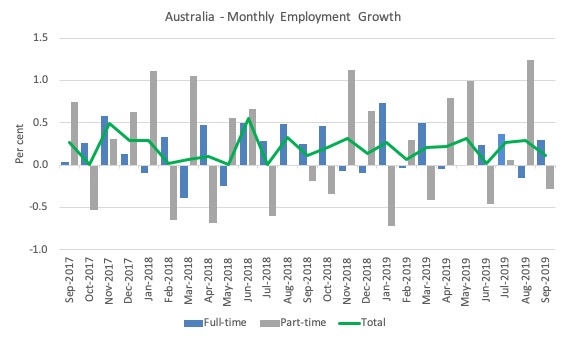
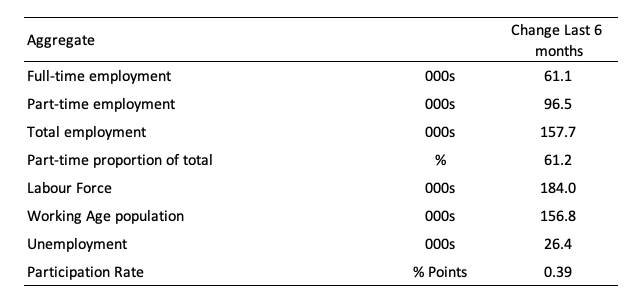
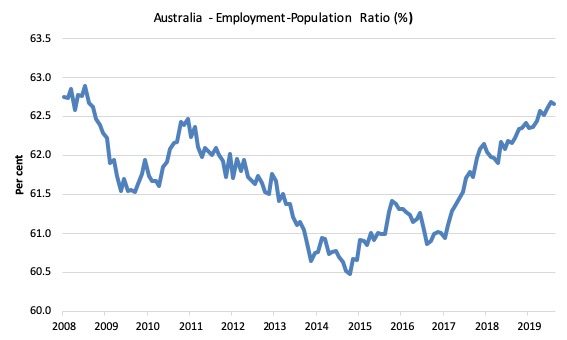
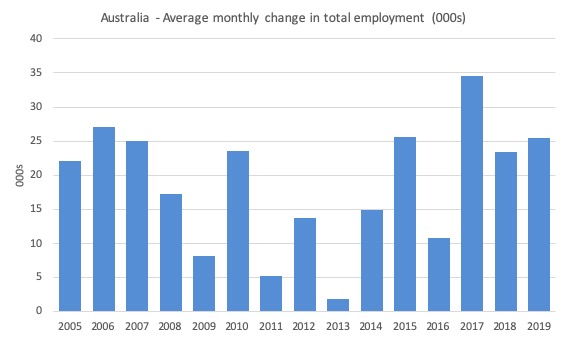
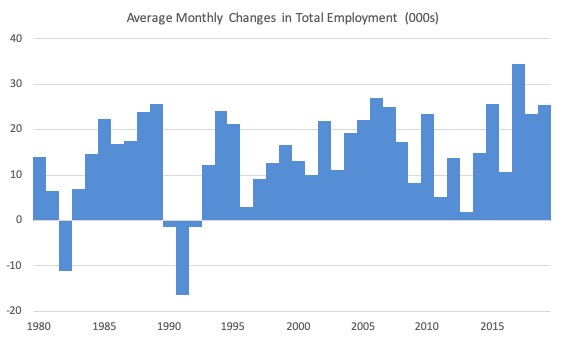
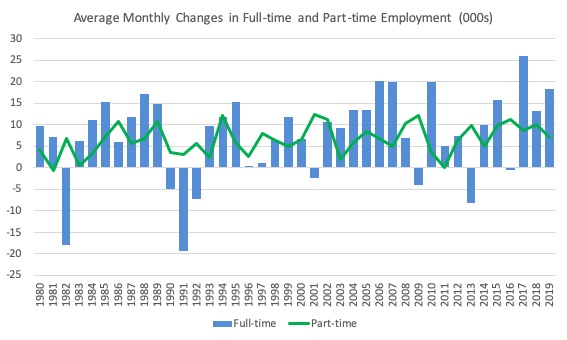
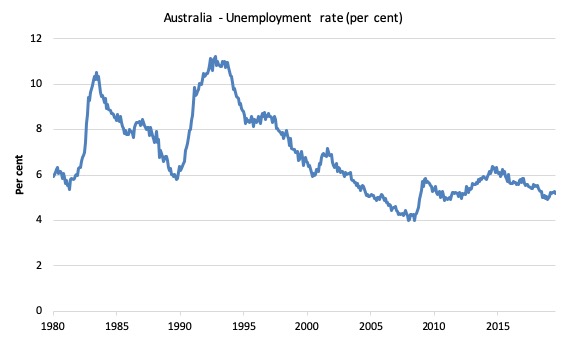
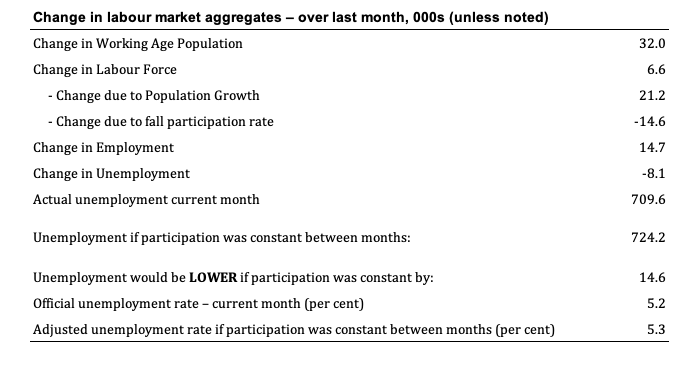
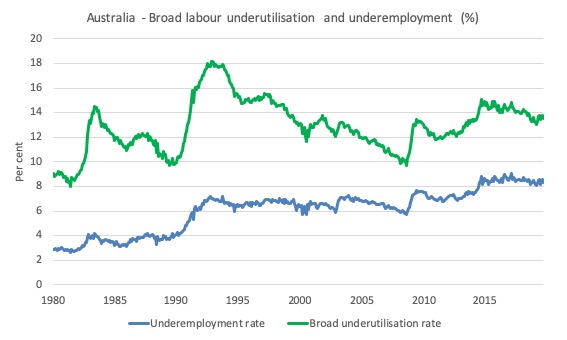
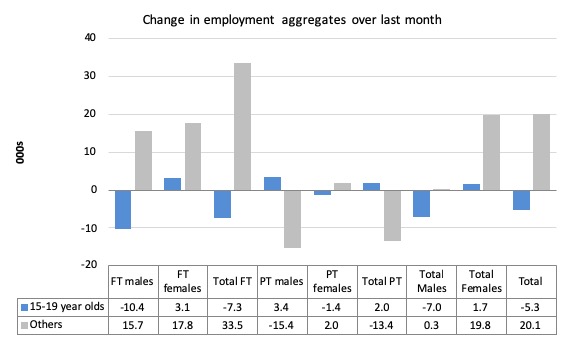
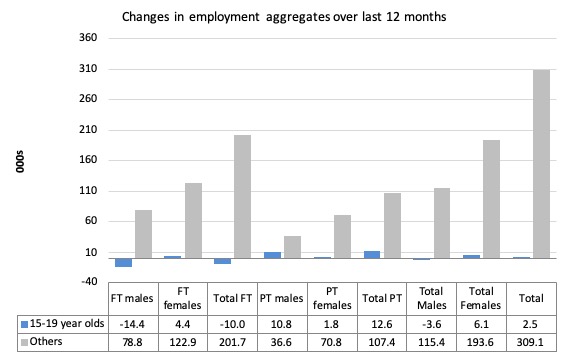
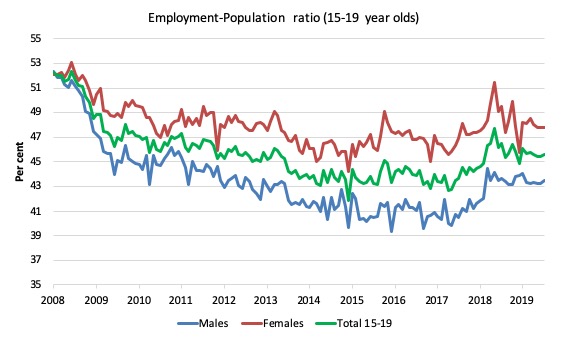
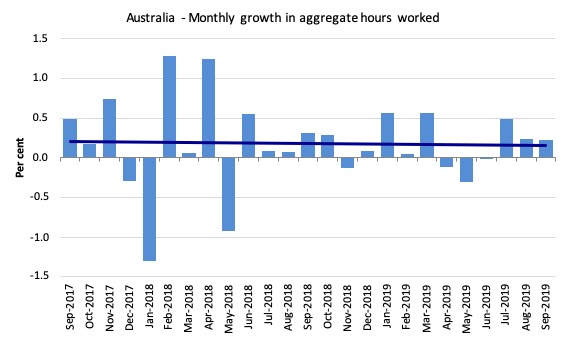
Everytime when i hear people use the word – ‘efficiency’ – in academia, I just chuckle a little bit.
Until the broader labor participation metrics replace the simple unemployment rate in the public discourse, governments will not feel the necessary pressure to take responsibility for supporting aggregate demand in the face of the propensity to save among private sector households and companies.
@ eg,
OTOH, small business owners might feel the need to boost their profits by letting the gov. cause the economy to provide a lot more money for their customers so they can buy more stuff from the small business owner.
A JG program would do this by paying all the unemployed and underemployed about $25/hr with their JG job. All the low paid people in private employ would also get a raise to $15/hr. OTOH, the small business owner would have to pay his staff at least $15/hr.
It becomes an interesting question of will the business get so much more business from more people that it can pay its staff $15/hr. and still make more money for the owner.
Data from cities like Seattle seems to say that a larger minimum wage does do this. And here the gov. is providing a big chunk of the additional income in the economy by just spending dollars into the economy. Or, selling bonds to deficit spend. This should create much more demand than the extra costs to the business. A fairly simple spreadsheet ought to be enough to prove that this is the case in every situation.